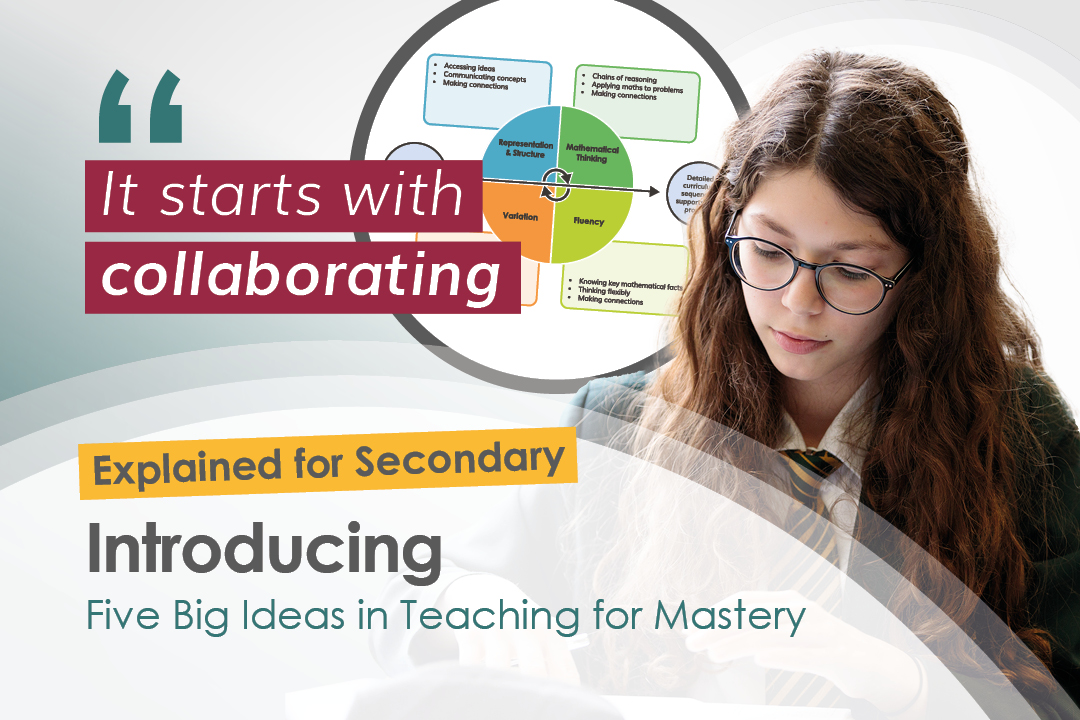An Introduction to the Five Big Ideas at Secondary
In an introduction to our series on the Five Big Ideas at Secondary, we explore the principles that underpin teaching for mastery
11/07/2024

Carol Knights, the NCETM’s Director for Secondary, explains what teaching for mastery means in a secondary context and how it is far more than what goes on in a maths classroom.
What is teaching for mastery?
Teaching for mastery is an approach to teaching maths which is underpinned by a set of principles. The most important of these is that all children can learn and enjoy maths. The Ofsted maths subject report, Coordinating Mathematical Success, highlighted that previously lower attaining students often don't have the same opportunities to reason, think, communicate and solve problems as their higher attaining peers. We need to ensure that all children have equal access to learning maths, and teaching for mastery provides that.
How can teachers develop this mindset of ‘access for all’?
Teachers may have preconceptions about what students can do, but often they can do more than we think. It’s really important that all teachers have high expectations of students’ capacity to access the maths they are learning. One way to achieve that is to ensure that they are active participants in their own learning, and teaching for mastery is an approach that really supports that.
It's a process that leads to having students who are engaged in whatever it is they're learning. Students need to think, they need to reason, and they need to make connections, so that they really understand what the maths is all about. Harnessing the Five Big Ideas of Teaching for Mastery helps us to support them to achieve that.
What are some of the misconceptions about mastery?
Teaching for mastery is not about rote learning or sticking rigidly to a curriculum. It is about what happens in maths departments, and it starts with teachers collaborating, trying out new approaches, thinking together and talking about the maths they are teaching. It focuses on how teachers achieve this endpoint of students engaged fully with their learning, as active participants, in the classroom.
A scheme of work should not be something that sits on a dusty shelf. Whether schools use a commercial scheme, or they have developed their own, it should be a living document that teachers contribute to, review, and challenge. Is it right for their students? What went well last time? How it can be improved upon?
There can also be a misconception that teaching for mastery should only be carried out in mixed attainment groupings, but it is an approach that works in all settings, whether that's mixed attainment groupings or groups set by prior attainment. These are decisions taken at a departmental level, based on what will work best for the students in front of each teacher.
- Understand: What is mastery?
What is the purpose of the Five Big Ideas in Teaching for Mastery?
Schools and teachers engaged with teaching for mastery are focused on achieving a consistent approach. Coherence is the ‘Big Idea’ that holds everything together. It’s important to avoid students who go from one teacher to another and encounter completely different teaching approaches, and completely different sets of representations. They need to have a seamless experience and that is developed within the department and within whichever phase of learning they're in. It is an approach which links to previous learning from Key Stage 2 and anticipates future learning in Key Stages 3 and 4, and into post-16.
The other ‘Big Ideas’, such as variation, representation and structure, mathematical thinking, and fluency, are all key concepts in teaching for mastery. They work together to support the development of a mathematical toolkit of conceptual understanding, flexibility, mental structures and deep knowledge that students can use to become engaged and active participants in their learning. But this all starts with teachers, working together, in their departments to develop their approach and get the most out of their curriculum.
If you’d like to know more about the Five Big Ideas in Teaching for Mastery at secondary, look out for our new explainer series on the topic.
Keen to find out more?
Watch the explainer video, which summarises Carol's introduction to the Five Big Ideas in Teaching for Mastery: